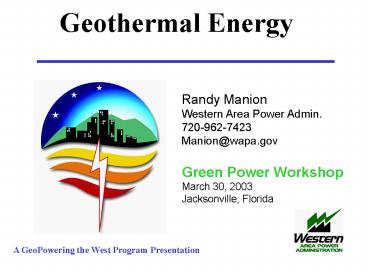Geothermal Energy PowerPoint PPT Presentation
1 / 24
Title: Geothermal Energy
1
Geothermal Energy
Randy Manion Western Area Power Admin.
720-962-7423 Manion_at_wapa.gov Green Power
Workshop March 30, 2003 Jacksonville, Florida
A GeoPowering the West Program Presentation
2
- Announced January 2000
- Program to dramatically increase the use of
geothermal energy in U.S. - Increased focus on direct use
- Regionally based
- Focus on priority areas
- Leverage resources and replicate results
- Coordinated activities
- Double the number of states, from
- 4 to 8, with geothermal electric
- power facilities by 2010.
- Supply the electrical power or
- heat of 7 million homes and
- businesses in the U.S. by 2015.
3
The Approach
National Energy Situation Volatile electricity
and fuel markets Priorities Cost stability,
efficiency, sufficiency, and sustainability Signif
icant opportunities for geothermal power
production/heat use
Users, customers (market pull) requirements
GPW info, Technical Assistance
Technology Advancement and Deployment
Resource Exploration and Confirmation
RFPs, Geothermal Systems
Policy Issues
Institutional Improvements
Education and Outreach
Federal Aggregation
Communications
Technology (technology push)
Geothermal RD Program
4
The Vision
- Through Public-Private Partnerships
- Ensure ready access to public lands to secure
good geothermal resources and construct
transmission lines - Thoroughly map all potential resource areas
- Have a cost-competitive technology
- Have readily accessible technical resources, case
studies and other decision making information - Identify buyers
5
Source EnergyAtlas
Identifying Buyers
6
Strategic Objectives
- Educate the stakeholders and increase public
awareness. - Organize a state Geothermal Energy Working Group.
- Promote water policies that encourage the use of
geothermal energy. - Encourage the development of geothermal energy.
- Increase technical knowledge and understanding of
geothermal energy. - Promote financial assistance for geothermal
energy projects. - Promote innovative and broader use of geothermal
energy. - Promote opportunities for geothermal electric
power development. - Identify and seek working group funding.
7
GPW Resources
- Resource Assessment
- Engineering Technical Assistance
- Legal, regulatory and environmental
- Finance
- Communications
- Land use and permitting
- Social issues
- State working group interface
- Public Renewable Partnership
8
Team Contacts
- Susan Norwood, National Coordinator from U.S.
DOE, 202-586-8185 - Roger Hill, Technical Leader from Sandia,
505-844-6111 - Randy Manion, Public Renewables Partnership Lead
from WAPA, 720-962-7423 - Gerry Nix, NREL, 303-384-7566
- Bob Neilson, INEL, 208-526-8274
- Gordon Bloomquist, WSU, 360-956-2016
9
Partners
- DOE Geothermal Technologies Program
- DOE Seattle and Denver Regional Offices
- DOE Power Marketing Administrations
- Other Federal Agencies (DOI, USDA)
- National Laboratories (INEEL, NREL, SNL)
- Industry/Trade Association (GEA, GRC, GEA,BLA)
- Universities (OIT,UNR Great Basin Center)
- Non-Profit Organizations (NCSL, Resolve)
10
Geothermal Resource Map
Additional States With Geothermal Development
Potential -Alaska -Idaho -Arizona -New
Mexico -Colorado -Oregon -Wyoming
- U.S. Installed Capacity (2,800 MW)
- California 2500 MW
- Nevada 200 MW
- Utah 40 MW
- Hawaii 30 MW
11
Geothermal Electricity
- Currently over 7,000 MWe installed capacity
worldwide, 2,800 MWe in U.S. - U.S. geothermal industry leads the worldwide
market for geothermal power development Unocal,
CalEnergy, Calpine, Oxbow, Caithness, Ormat
12
Attributes of Geothermal Power
- Advantages
- Enormous potential (up to 25,000 MW in North
America) - High, reliable plant capacity factor (gt90)
- Greenhouse gas reduction
- Low environmental impact
- Takes advantage of mature thermal plant technology
- Disadvantages
- Expensive drilling
- Regional, localized resource
- Resource uncharacterized
- Threshold plant size
- Plant prefers constant load
- Environmental perception
13
Geothermal Applications
Courtesy of Geothermal Education Association
- Electricity Generation
- Central Station Power
- Distributed Power
- Heat Production
- District Heating
- Industrial Process Heat
- Agriculture
- Aquaculture
- Mineral Recovery
- Zinc
- Silica
14
Flash Steam Power Plant
Steam
Turbine
Flash Tank
Generator
Electricity
Condensed Steam (Water)
Hot Water
Separated Water
15
Binary Cycle Geothermal Plant
16
Direct Use Applications
Direct use displaces about 1.6M
barrels of oil annually in the
United States.
- District Heating
- Process Heat
- Agriculture
- Aquaculture
- Balneology (hot spring and water bathing)
17
Significant Energy Production
Geothermal power plants produce almost 5 of
California's electricity (12.8 million MWh in
1999)
This hybrid binary/flash power plant provides
about 25 of electricity demand on the Big Island
of Hawaii
18
Challenges to Geothermal Development
Competition with fossil fuels Financing Long
project lead times Siting and permitting Obvious
sites already taken Industry focus overseas Large
projects at high costs Exploration cost and risk
19
Major Issues
Institutional Issues
- Utility market
- Market uncertainty
- Financial institutions
- High oil prices
- Public ignorance
- Environmental protests
Technical Issues
Reservoir location and characterization Reservoir
enhancement Fluid treatment in power
plants High-cost drilling and completion
20
Research Needs
- Cheaper drilling
- Better reservoir exploration and identification
- Better reservoir evaluation and management
- More efficient power plants for lower temperatures
21
A Vision for the Future
- Ready Access to Land
- Thoroughly Mapped and Developed Resources
- Cost Competitive Technology
22
In the Future.
23
Environmental Drivers
As global concern about possible climate change
intensifies, support for geothermal and renewable
energy will grow.
24
Consumer Demand
Polls show consumers are concerned about the
environment and want utilities to use renewables.

